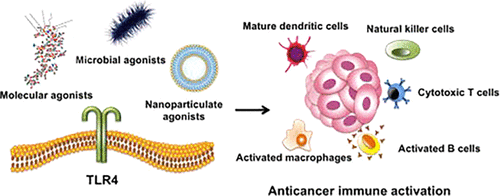当前位置:
X-MOL 学术
›
Mol. Pharmaceutics
›
论文详情
Our official English website, www.x-mol.net, welcomes your feedback! (Note: you will need to create a separate account there.)
TLR4-Based Immunotherapeutics in Cancer: A Review of the Achievements and Shortcomings
Molecular Pharmaceutics ( IF 4.9 ) Pub Date : 2018-09-18 00:00:00 , DOI: 10.1021/acs.molpharmaceut.8b00691 Maryam A. Shetab Boushehri 1 , Alf Lamprecht 1, 2
Molecular Pharmaceutics ( IF 4.9 ) Pub Date : 2018-09-18 00:00:00 , DOI: 10.1021/acs.molpharmaceut.8b00691 Maryam A. Shetab Boushehri 1 , Alf Lamprecht 1, 2
Affiliation

|
Toll-like Receptor 4 (TLR4) agonists have had a long journey in the field of cancer immunotherapy. Nevertheless, despite the remarkable number of the TLR4 ligands that have gone through various preclinical and clinical stages, only two (Bacillus Calmette–Guérin (BCG) and monophosphoryl lipid A (MPLA)) have hitherto obtained the FDA approval for clinical application in cancer treatment. This paper provides a comprehensive review of the TLR4 agonists’ journey as cancer active immunotherapeutics. Following a brief discussion of the rationale behind the use of TLR ligands in cancer immunotherapy, we will initially focus on the forerunner of the TLR4 agonists, bacterial lipopolysaccharide (LPS). Within this context, the potentials and shortcomings of immunotherapy with this agent will be addressed, the strategies that have been devised to enhance the associated therapeutic outcome will be discussed, and the consequent achievements and shortcomings will be summarized. Subsequently, further and perhaps less well-known, molecular, bacterial, and viral TLR4 agonists with potential for cancer immunotherapy will be introduced, and if present, the outcome of the preclinical and clinical investigations of these agents will be reviewed. Finally, a look will be cast upon the promising souvenirs of the relatively new arena of nanotechnology, where TLR4 activating nanoparticulate systems will be proposed as potential candidates for the future development of this field.
中文翻译:

基于TLR4的癌症免疫治疗:成就和缺点的回顾
Toll样受体4(TLR4)激动剂在癌症免疫治疗领域已经走了很长一段路。尽管如此,尽管经历了不同的临床前和临床阶段的TLR4配体数量惊人,但迄今只有两种(卡介苗(BCG)和单磷酰脂质A(MPLA))已获得FDA的临床批准用于癌症治疗。本文对TLR4激动剂作为癌症活性免疫疗法的历程进行了全面回顾。在简要讨论了在癌症免疫治疗中使用TLR配体背后的原理之后,我们将首先关注TLR4激动剂的前身细菌脂多糖(LPS)。在这种情况下,将解决使用这种药物进行免疫疗法的潜力和不足,将讨论为提高相关治疗效果而设计的策略,并总结由此带来的成就和缺点。随后,将介绍具有癌症免疫疗法潜力的其他的,也许不太为人所知的分子,细菌和病毒TLR4激动剂,如果存在,将审查这些药物的临床前和临床研究的结果。最后,将对相对较新的纳米技术领域的有前途的纪念品进行研究,其中将提出TLR4活化纳米颗粒系统作为该领域未来发展的潜在候选者。细菌和病毒TLR4激动剂具有潜在的癌症免疫治疗作用,将被介绍,如果存在的话,将审查这些药物的临床前和临床研究的结果。最后,将对相对较新的纳米技术领域的有前途的纪念品进行研究,其中将提出TLR4活化纳米颗粒系统作为该领域未来发展的潜在候选者。细菌和病毒TLR4激动剂具有潜在的癌症免疫治疗作用,将被介绍,如果存在的话,将审查这些药物的临床前和临床研究的结果。最后,将对相对较新的纳米技术领域的有前途的纪念品进行研究,其中将提出TLR4活化纳米颗粒系统作为该领域未来发展的潜在候选者。
更新日期:2018-09-18
中文翻译:

基于TLR4的癌症免疫治疗:成就和缺点的回顾
Toll样受体4(TLR4)激动剂在癌症免疫治疗领域已经走了很长一段路。尽管如此,尽管经历了不同的临床前和临床阶段的TLR4配体数量惊人,但迄今只有两种(卡介苗(BCG)和单磷酰脂质A(MPLA))已获得FDA的临床批准用于癌症治疗。本文对TLR4激动剂作为癌症活性免疫疗法的历程进行了全面回顾。在简要讨论了在癌症免疫治疗中使用TLR配体背后的原理之后,我们将首先关注TLR4激动剂的前身细菌脂多糖(LPS)。在这种情况下,将解决使用这种药物进行免疫疗法的潜力和不足,将讨论为提高相关治疗效果而设计的策略,并总结由此带来的成就和缺点。随后,将介绍具有癌症免疫疗法潜力的其他的,也许不太为人所知的分子,细菌和病毒TLR4激动剂,如果存在,将审查这些药物的临床前和临床研究的结果。最后,将对相对较新的纳米技术领域的有前途的纪念品进行研究,其中将提出TLR4活化纳米颗粒系统作为该领域未来发展的潜在候选者。细菌和病毒TLR4激动剂具有潜在的癌症免疫治疗作用,将被介绍,如果存在的话,将审查这些药物的临床前和临床研究的结果。最后,将对相对较新的纳米技术领域的有前途的纪念品进行研究,其中将提出TLR4活化纳米颗粒系统作为该领域未来发展的潜在候选者。细菌和病毒TLR4激动剂具有潜在的癌症免疫治疗作用,将被介绍,如果存在的话,将审查这些药物的临床前和临床研究的结果。最后,将对相对较新的纳米技术领域的有前途的纪念品进行研究,其中将提出TLR4活化纳米颗粒系统作为该领域未来发展的潜在候选者。



























 京公网安备 11010802027423号
京公网安备 11010802027423号